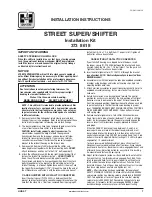
4-5. Use other driving system
205
4
Driv
in
g
CAUTIONS
■
Pay special attention to the people animals, and various obstacles around the vehicle. The sensors
have undetectable blind spots.
■
When looking for a parking space or during parking, make sure that there are no obstacles in the
parking space, such as stones, thin pillars or drawbars, because the system may be not able to detect
such obstacles.
■
The system may not be able to recognize the surface or structure of certain objects (such as barbed
wire, fences, snowdrifts, etc.) Therefore, check whether there is enough space in the parking space
displayed before parking your vehicle.
■
The parking radar system detects an obstacle. The car approaching the obstacle may disappear
within the detection range of the sensor (this is very easy to happen when detecting obstacles that are
too high or too low). As a result, these objects cannot be detected. Do not ignore the warning from the
parking distance alarm system, otherwise, the vehicle may have the risk of collision.
■
Due to the influence of various external sound fields and electromagnetic fields (e.g. other vehicles
using ultrasonic ranging, air pressure, engine noise, electronically controlled gears, induction coils,
etc.), the system cannot achieve absolute anti-interference.
■
The anti-interference ability and detection performance of ultrasonic ranging may be reduced due to
environmental conditions and obstacle reflection characteristics. This is determined by the physical
strength of ultrasonic propagation.
■
The installation position of the sensor has an important influence on the system performance. It is
reflected in the reflection of the bumper surface itself, ground echo reflection and detection range.
■
Avoid using high pressure cleaner or steam cleaner to clean the sensors, so as not to damage the
sensors. Adopt small water stream to wash the sensor surface for a short time during vehicle cleaning,
and maintain a distance over 10 cm.
■
The sound waves transmitting in the air is refracted and diffracted based on the physical properties.
The difference in temperature in the air is one of the most important factors in the generation of
non-uniform propagation media, thereby leading to acoustic diffraction.
■
The detection performance of ultrasonic detection equipment will be affected by the following
factors:
●
Hot exhaust gas.
●
High-temperature asphalt pavement.
●
Summer breeze.
●
Temperature stratification.
■
When there is a difference between the bumper temperature and the ambient air temperature
(which usually occurs in winter), temperature stratification will occur, resulting in sound wave
diffraction and reflection echo under a specific bumper structure, thus posing a false alarm risk.
■
Some important factors that can lead to a reduced detection range or no detection:
●
The bumper surface is covered with snow or sludge.
●
The sensor surface is covered with lime mud or ice.
●
High acoustic attenuation (for example, in a dry and hot environment).
●
In heavy rain or foam.
●
Obstructions with absorbing materials.
●
When the edges and corners of flat obstacles are facing the sensor, the reflected echo only occurs within a
specific angle range.
Summary of Contents for HS5
Page 2: ......
Page 24: ...22 ...
Page 74: ...2 Instrument Cluster 72 ...
Page 378: ...8 2 Measures to Be Taken in Emergencies 376 ...
Page 379: ...377 9 Specifications Maintenance data 378 Fuel information 390 Vehicle specification 9 ...
Page 395: ...393 List of Abbreviations 394 Other information ...
















































